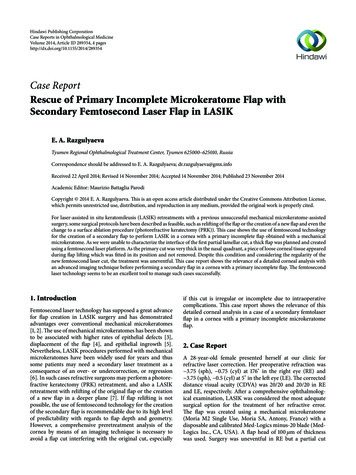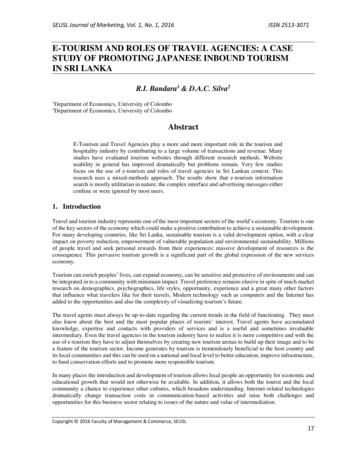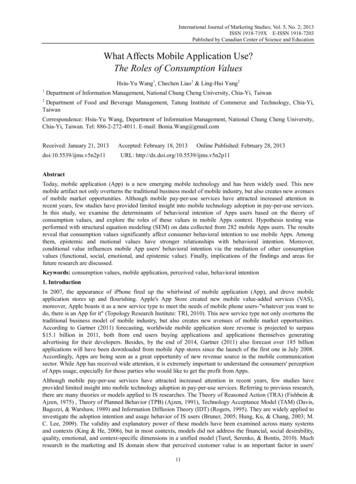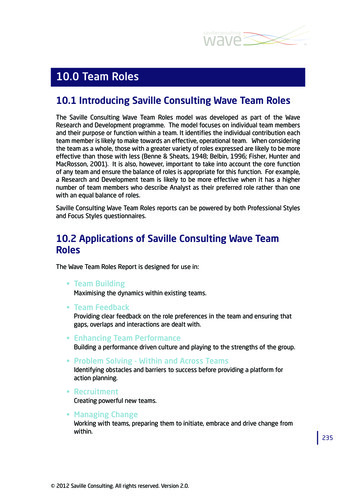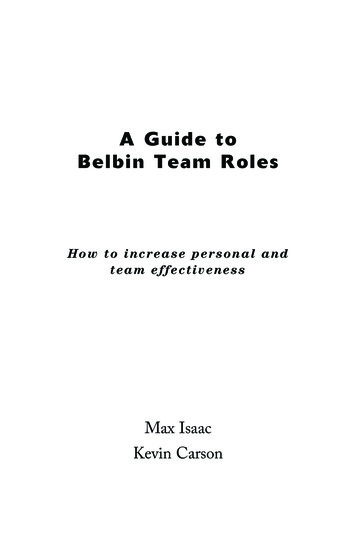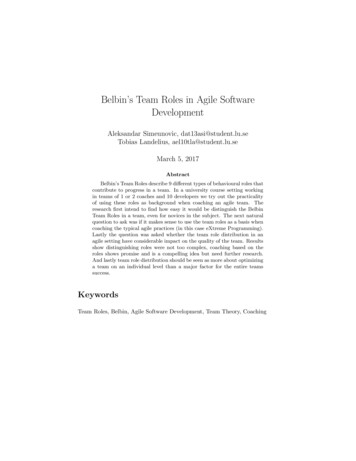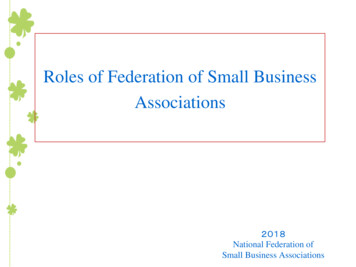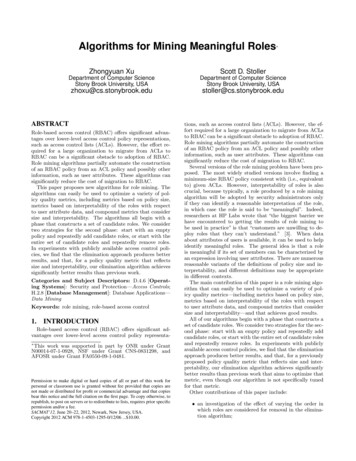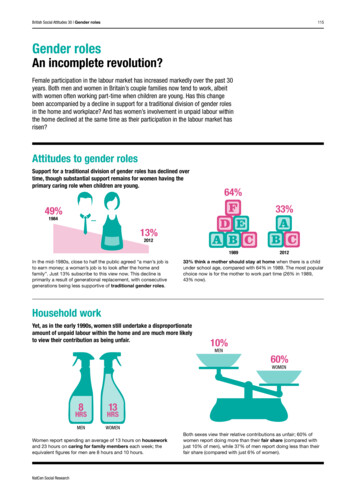
Transcription
British Social Attitudes 30 Gender roles115Gender rolesAn incomplete revolution?Female participation in the labour market has increased markedly over the past 30years. Both men and women in Britain’s couple families now tend to work, albeitwith women often working part-time when children are young. Has this changebeen accompanied by a decline in support for a traditional division of gender rolesin the home and workplace? And has women’s involvement in unpaid labour withinthe home declined at the same time as their participation in the labour market hasrisen?Attitudes to gender rolesSupport for a traditional division of gender roles has declined overtime, though substantial support remains for women having theprimary caring role when children are young.49%198413%2012In the mid-1980s, close to half the public agreed “a man’s job isto earn money; a woman’s job is to look after the home andfamily”. Just 13% subscribe to this view now. This decline isprimarily a result of generational replacement, with consecutivegenerations being less supportive of traditional gender roles.64%FD EA B CAB C1989201233%33% think a mother should stay at home when there is a childunder school age, compared with 64% in 1989. The most popularchoice now is for the mother to work part time (26% in 1989,43% now).Household workYet, as in the early 1990s, women still undertake a disproportionateamount of unpaid labour within the home and are much more likelyto view their contribution as being unfair.10%MEN60%WOMEN813hrshrsMENWOMENWomen report spending an average of 13 hours on houseworkand 23 hours on caring for family members each week; theequivalent figures for men are 8 hours and 10 hours.NatCen Social ResearchBoth sexes view their relative contributions as unfair; 60% ofwomen report doing more than their fair share (compared withjust 10% of men), while 37% of men report doing less than theirfair share (compared with just 6% of women).
British Social Attitudes 30 Gender roles116IntroductionAuthorsJacqueline Scott andElizabeth CleryJacqueline Scott is Professorof Empirical Sociology at theUniversity of Cambridge. ElizabethClery is Research Director atNatCen Social Research and aCo-Director of the British SocialAttitudes survey seriesFamilies in contemporary society are becoming more individualised. Theso-called nuclear family norm of a married heterosexual couple bringing uptheir children, with a traditional gender division of labour, is increasingly underchallenge. There has been a rise in women’s participation in the labour marketover the past few decades and, in today’s couple families, the tendency is forboth partners to work. However, women, especially those with young children,still disproportionately work part-time, and they still do the bulk of unpaid care.So, this suggests that, at least as yet, we have not seen a so-called ‘genderrole revolution’ (Esping-Andersen, 2009).In this chapter, we ask whether there is evidence that the increase we have seenin women’s labour market participation is coupled with a more widespread shift inperceptions about gender roles. In other words, we report how far a gender rolerevolution has been evolving in Britain in the last 30 years, and whether it seemsset to continue to progress or whether it has now run its course. Firstly, usingquestions fielded on British Social Attitudes since 1984, we chart changes in publicattitudes to mothers playing a dual role in paid work and raising children, and whatis seen as the appropriate division of labour in this respect between mothers andfathers. And we take a closer look, with new questions fielded in 2012, at howpeople think couple families should divide their work and familial responsibilities.By looking at generational change in attitudes, we try to unpick what is driving orhindering change towards greater gender egalitarianism.While the malebreadwinner familysystem has been indecline for at least half acentury, concerns about‘work-family conflict’have only been voicedmore recentlyWith the rise inmothers’ labour marketparticipation, there is arole for policy measuresthat seek to reduce familywork conflictsNatCen Social ResearchSecondly, we report on what couples say about their own division of labourwithin the household – who does what at home – to see the extent to whichthings have changed over the past 30 years. While the male breadwinnerfamily system has been in decline for at least half a century, concerns about‘work-family conflict’ have only been voiced more recently. Some argue thatthe only way that family conflicts associated with women’s labour marketparticipation can be avoided is if men take on more of the housework andchildcare (Witherspoon and Prior, 1991; Lewis et al., 2008; Himmelweit, 2010).So, in 2012, are men doing more of the household tasks than they used to, orare women still expected to do a ‘second shift’, adding employment to theirprimary responsibility for housework and family care (Hochschild, 1989)? Aswell as looking at what men and women do within the household, we alsolook at whether or not they perceive their own division of unpaid labour as fair,and whether they feel conflicted by their responsibilities at work and at home.Importantly, in addressing the question of whether there is evidence of a genderrole revolution, we report on how these perceptions have changed over time.Certainly, with the rise in mothers’ labour market participation, there is a role forpolicy measures that seek to reduce family-work conflicts, including childcareprovision, improvement in part-time working conditions and parental leave. In theUK there was little relevant policy on such issues until the 1990s. After 1997 therewas a surge in policies designed to support the ‘adult-worker model’, wherebymothers, including lone mothers, were encouraged to work (Lewis, 2008). From1997 onwards steps have been taken to improve childcare provision (e.g. SureStart was launched in 1998). However, childcare in Britain remains among themost expensive in Europe (Schober and Scott, 2012). The Part-Time WorkDirective (1997) was an important advance, stipulating that part-time workerswere entitled to the same benefits as full-time workers, in terms of training, payand parental leave. In reality, parental leave provision in the UK is mainly about
British Social Attitudes 30 Gender roles117maternity leave, which became a statutory right in the 1999/2001 EmploymentRelations and Employment Act (Williams, 2004). While paternal leave entitlementhas improved somewhat since it was first introduced in 2003, it remains the casethat few families can afford to take it up, as income loss is often prohibitive. Evenso largely symbolic policies – like the notion of shared parental leave – do matter,because they encourage fathers to get more involved in the care of infants.It is questionable as to how far the public will endorse policies that are costly ata time of economic crisis, when the country has to restrict public expenditure.We conclude the chapter by examining current attitudes to parental leave whena new child is born. Does the public favour policy measures which promote agreater merging of gender roles in the home and workplace, or do preferencesreflect the status quo? These are big issues which get to the heart of questionsabout how far the state should be involved in shaping family life, gender equality,and parental rights and responsibilities.Our chapter builds on a wealth of literature about family and gender role change,providing an up-to-date picture of Britain today. Given some suggestion of amore recent retreat from gender egalitarianism because of concerns voicedabout potential conflicts between maternal employment and family wellbeing,especially for families with young children (Scott, 2010), we look for any changesto earlier findings about public support for mothers’ dual paid work and familyroles (Witherspoon and Prior, 1991; Scott et al., 1996).Participation in the labour marketChanges in women’s participation in the labour market over the past 30 yearsgive important context to our later findings on the general attitudes of the publicand the personal views of couples about their own circumstances. Behaviouraland attitudinal changes often flow in both directions. Thus, more women enteremployment as female participation is viewed as more acceptable, and moreacceptance follows in the wake of women’s increased labour market participation.Since the early 1980s (when our British Social Attitudes questions on genderroles were first asked), there has been substantial change in the extent and waysin which women have participated within the British labour market. In Figure 5.1we present data from the Office for National Statistics’ Labour Force Survey toshow how men and women’s participation in the labour market has changedover the past three decades to 2012.From the mid-1990s,full-time employmentfor both women andmen continued togrow steadily and thegap between men andwomen’s employment isnarrowingNatCen Social ResearchFrom the mid-1990s, full-time employment for both women and men continued togrow steadily and the gap between men and women’s employment is narrowing.The dip for men in the 1980s and early 1990s partly reflects an increasingnumber of men over 55 taking early retirement (Guillemard, 1989). More recentlyfrom 2009 onwards, the dip in both men’s and women’s full-time employmentis associated with the global economic crisis. (The rise in the relatively smallnumbers of men in part-time employment reflects, in part, increased numbersin higher education, with students supplementing grants with part-time jobs).For women, the growth in full-time employment from the mid-1990s onwardswas stronger than the growth in part-time employment. As part-time work isoften used by women – and mothers in particular – to juggle family and workresponsibilities, it is worth looking more closely at the statistics associated withthe work-patterns of women, with and without dependent children.
British Social Attitudes 30 Gender roles118Figure 5.1 Trends in employment by hours worked and sex, Great Britain1984–2012Male full-timeFemale full-timeFemale part-timeMale 084 85 86 87 88 89 90 91 92 93 94 95 96 97 98 99 00 01 02 03 04 05 06 07 08 09 10 11 12Data show the number of people aged 16–64 in employment divided by the population aged 16–64. Data areseasonally adjustedSource: Labour Force Survey, data available at: he data on which Figure 5.1 is based can be found in the appendix to this chapterIn 2010, a higherproportion of mothersstill worked part-time(37 per cent) rather thanfull-time (29 per cent),sharing their timebetween work andlooking after the familyWomen’s participation in paid employment has been encouraged by UK andEU policies aimed at reducing barriers to work caused by conflicting work andfamily life responsibilities (Lewis, 2012). Such policies have gone hand-in-handwith a marked increase in the proportion of mothers in the labour force and anarrowing in the gap between the employment rates of women with and withoutdependent children such that, in 2010, there was less than one percentagepoint difference in the participation rates of mothers (66.5 per cent) and womenwithout dependent children (67.3 per cent) (Office for National Statistics, 2011).In 2010, a higher proportion of mothers still worked part-time (37 per cent)rather than full-time (29 per cent), sharing their time between work and lookingafter the family.Our chapter focuses on the division of labour within couple families. For mothersin couple families, where there are increased opportunities to share childcareresponsibilities, employment rates were higher (72 per cent in 2010) than formothers in single-parent families (55 per cent) (Office for National Statistics,2011). And, unsurprisingly, the Labour Force Survey statistics also show that, asthe age of the youngest child in the family increases, so does the proportion ofmothers in work.Attitudes to gender roles: change over timePeriodically since the mid-1980s, British Social Attitudes surveys have includedattitudinal questions asking about the roles of men and women within the family,in particular around providing an income from work versus playing a caring rolein the home. Tracking responses to these questions over the past three decades,we report on whether, in line with women’s increased participation in the labourmarket, there have also been changes in what the public believes men’s andwomen’s roles should be. Have we reached a point where the public thinks thatmen and women should have equal roles in the workplace and at home? Or isthere still a perception that there should be a gender divide?NatCen Social Research
British Social Attitudes 30 Gender roles119Figure 5.2 shows the percentage of people who agree to each of the followingtwo statements about the gender division of responsibilities around providing anincome versus looking after the home:A man’s job is to earn money; a woman’s job is to look after the home andfamily [1]Both the man and woman should contribute to the household incomeFigure 5.2 Attitudes to gender division of responsibilities, 1984–2012% agree both the man and woman shouldcontribute to the household income% agree a man’s job is to earn money; a woman’sjob is to look after the home and family100%90%80%70%60%50%40%30%20%10%0%84 85 86 87 88 89 90 91 92 93 94 95 96 97 98 99 00 01 02 03 04 05 06 07 08 09 10 11 12The data on which Figure 5.2 is based can be found in the appendix to this chapterIn the mid-1980s, closeto half (43 per cent in1984 and 48 per centin 1987) of peoplesupported a genderedseparation of rolesThere is considerablesupport for both men andwomen contributing to thehousehold incomeIn the mid-1980s, close to half (43 per cent in 1984 and 48 per cent in 1987)of people supported a gendered separation of roles, with
family life responsibilities (Lewis, 2012). Such policies have gone hand-in-hand with a marked increase in the proportion of mothers in the labour force and a narrowing in the gap between the employment rates of women with and without dependent children such that, in 2010, there was less than one percentage point difference in the participation rates of mothers (66.5 per cent) and women .
